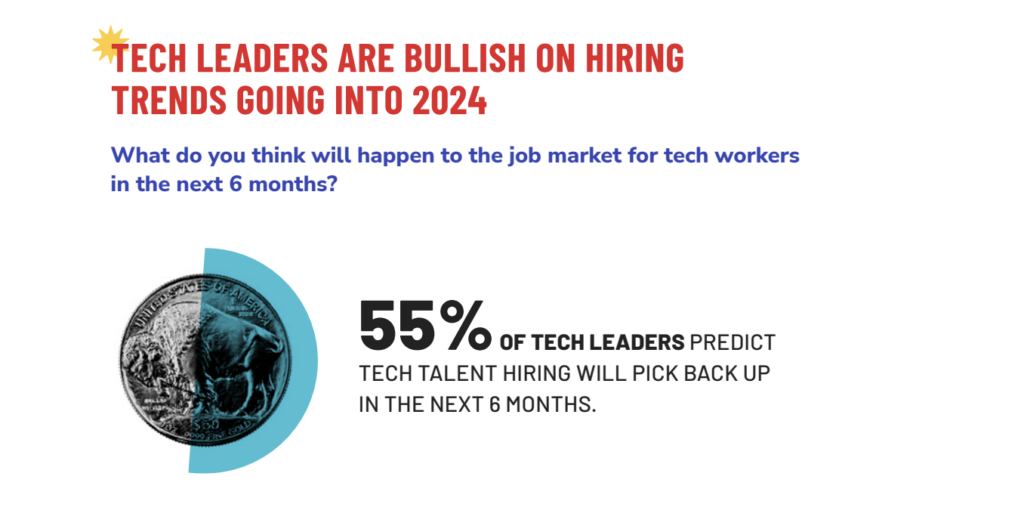Layoffs have become an unsettling norm across industries. Companies that rapidly staffed up during the pandemic in response to surging demand are trimming staff as demand wanes. It’s a vicious cycle — many of these companies will be hiring again within the next year to keep up with a constantly shifting consumer landscape.
Most recent layoffs have disproportionately affected non-technical employees, hitting departments like human resources, recruiting, and marketing hard. They’ve also had other ripple effects — shelving diversity initiative progress and causing anxiety throughout the workforce. And to add to it all, companies are still struggling to recruit for tech roles and continuing to invest in digital transformation efforts in hopes they’ll be more efficient and competitive in the future. A future that’s already here.
TL;DR: There’s a severe imbalance in the labor force, and companies need to think about modernizing their workforce like they think about modernizing their tech. It’s time to move past the band-aid effect of layoffs and upgrade to a truly sustainable talent strategy.
Why you should reskill and redeploy employees instead of laying them off
While layoffs may offer immediate cost savings, they can damage your brand and erode trust. Word of layoffs travels fast — especially via social media. Letting employees go and then turning around hiring again a few months later (or for different roles) can leave candidates, employees, and even your customers with a bad taste.

Source: GA’s New Frontiers Study
Several studies have found that layoffs don’t necessarily translate to greater profits, but they do lead to hidden costs:
- You lose the valuable institutional knowledge of tenured employees who were let go.
- Employees left behind may be less productive and engaged due to anxiety, guilt, and low morale.
- Quality of work may decline as employees focus on productivity theater to keep their jobs.
- Fearing more cuts, staff are more likely to leave. A layoff affecting 1% of your workforce can lead to a 31% increase in voluntary turnover. This could complicate your talent management challenges while simultaneously damaging your reputation with candidates and new hires.
- Layoffs can often erode gains made toward your DEI goals. Women, people with disabilities, and other historically marginalized employee groups are often unintentionally let go disproportionately.
If layoffs are related to an imbalance of talent — say you have too many recruiters when you need more software engineers — your problem is actually a skills gap. The good news? A skills gap can be solved without layoffs.
So, what’s the solve? Reskill and redeploy.
Reskilling talent means teaching existing employees new skills so they can transition into new roles. Typically, there’s some tie between their original role and the new role — but there doesn’t have to be.
A great customer service representative who empathizes with customers and can creatively problem solve could make a great UX designer. A marketing specialist who codes email templates with HTML might quickly pick up CSS or other web development skills. A member of the finance team who’s adept at Excel already has some of the skills needed for a data analytics role. It’s all about aligning your existing capabilities with emerging roles and teaching your employees new technical skills in the process.
“Organizations that promote reskilling and invest in internal talent pools boost their reputation by being people-first. The value of creating a robust pipeline of employees that adapt to their client needs helps future-proof the organization and creates other long-term advantages.”
Erick Dominguez, Account Director at General Assembly
The tech skills gap is looming
Tech runs the modern world, and to continue growing your business, you’ll need to hire more tech talent. According to the World Economic Forum, 75% of companies are looking to adopt big data, cloud computing, and AI technologies in the next five years. In the U.S. alone, the Bureau of Labor Statistics (BLS) forecasts that high tech employment will grow 13% from 2020 numbers by 2030.
Unfortunately, the talent pool of traditional tech candidates available to fill those roles is very shallow. According to our research, 91% of HR professionals are concerned that their recruitment and hiring methods won’t be enough to fill open software engineer, data analytics, data science, and UX design positions. Yet most HR leaders continue to pursue the same tactics for recruitment and candidate screening that they always have.
Most companies haven’t considered the hidden tech talent that already exists within their organization. It’s highly likely that you have employees looking for a new challenge and eager to pick up new skills. With the average cost to fill a tech role at just under $30,000, doesn’t it make sense to consider investing a fraction of that to reskill an employee you already have?
Traditional talent sourcing is dead
The old ways of sourcing tech talent are out. Reskilling is a fresh approach that enables you to retain your workforce and remain competitive without resorting to layoffs.
Reskilling brings many win-win benefits:
- Workforce readiness = a strong pipeline of innovative talent. Leaders who empower employees to learn new skills to fill gaps are future-proofing their teams and encouraging an innovation mindset. Employees with diverse career backgrounds are more likely to be flexible, agile, and willing to adapt to emerging trends.
- Improved retention rates. Employees want to grow and learn new things throughout their careers. Reskilled workers tend to be happier, more productive, and more likely to stay in their roles for the long term.
- A culture of continuous learning. The skills that are critical today might be irrelevant in 2030 (or sooner). By fostering a culture of continuous learning, you can build a workforce that’s open to change and willing to consistently develop fresh skills.
- Boost productivity, save money. Reskilling and redeploying existing employees is much more cost-effective than competing to hire traditional tech talent. It can also boost productivity, as employees with strong institutional knowledge tend to be able to work faster and more collaboratively.
Building the next generation of tech talent: reskill or fizzle out
As the “Great Resignation” winds down, the “Big Stay” emerges. Fewer employees are quitting their roles, which means fewer open jobs and less talent on the market. While HR leaders might initially see this as a good thing, they must be ready for the tides to turn at any time. Today’s workforce is empowered, and employees have a low tolerance for poor workplace cultures or stagnant roles, even despite the Big Stay.
In today’s AI and tech-driven world, every industry is a tech industry. It’s time to change recruiting and talent development to match the tech surge. HR leaders must be proactive about planning for the future and building a resilient pipeline of employees with modern, in-demand tech skills. While your competitors are laying workers off, you can seize this opportunity to develop a truly sustainable tech talent approach.
The seemingly endless cycle of layoffs and hiring surges won’t get your talent strategy where it needs to be. Invest in a new approach to unlock the skills you need within your existing team and build a sustainable tech talent pipeline.
Contact us today to learn more.
